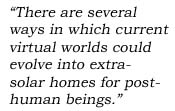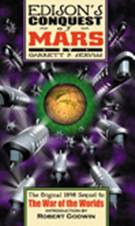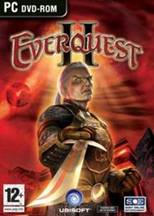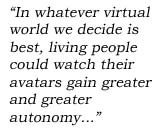Trajectories to the Heavens
William Sims Bainbridge, Ph.D.
Page 5 of 6
 There are several ways in which current virtual worlds could evolve into extrasolar homes for post-human beings. Most obviously, a version of World of Warcraft could be sent on an interstellar probe, populated entirely by AAs based on former players, then employ robot agents to transform a planet at the destination, complete with building a Stormwind city out of stone to duplicate the one that currently exists only electronically. Sample of the players’ DNA could then -- given substantial progress in the biological sciences -- produce biologically-based inhabitants that were also avatars of the original players. An interesting question is whether the simulation should run during the centuries-long voyage, risking extinction from cultural drift (Bainbridge, 1984) but giving the avatars the opportunity to learn and evolve beyond their original limitations.
There are several ways in which current virtual worlds could evolve into extrasolar homes for post-human beings. Most obviously, a version of World of Warcraft could be sent on an interstellar probe, populated entirely by AAs based on former players, then employ robot agents to transform a planet at the destination, complete with building a Stormwind city out of stone to duplicate the one that currently exists only electronically. Sample of the players’ DNA could then -- given substantial progress in the biological sciences -- produce biologically-based inhabitants that were also avatars of the original players. An interesting question is whether the simulation should run during the centuries-long voyage, risking extinction from cultural drift (Bainbridge, 1984) but giving the avatars the opportunity to learn and evolve beyond their original limitations.
More realistically, we should develop consistent protocols and database standards for creating virtual worlds. At present, most of them are incompatible with each other. For example, my WoW characters cannot visit Second Life. Actually, there is much discussion currently in the computer science community about developing standards for virtual worlds that would make objects and avatars portable from one to another. The protocols should allow “plug-in” AI agent modules, which themselves can access databases, to drive the avatars as human players currently do in online virtual worlds.
An important threshold will be crossed when the AI agents can operate robots external to the virtual worlds, directly interacting with the material world. Demonstration experiments could be carried out on the Moon and Mars, letting the system build cities that biological humans could then inhabit: colonies built by robots for human inhabitants. The Moon will clearly be a sketch pad, where many contradictory ideas are tried out and compared. I suggest that the most culturally interesting goal for Mars is to replicate there in reality all the influential fictional Martian cultures that were imagined before the first fly-by of a space probe in July 1965.
Small areas of the red planet could be devoted to classical short stories and to novels that depict limited regions, such as "AMartian Odyssey" by Stanley G. Weinbaum, “The Martian Chronicles” [1] by Ray Bradbury," and even the strange 1898 novel  by Garrett P. Serviss, Edison's “Conquest of Mars”, about how the great inventor turned back the invasion from H. G. Wells’ “War of the Worlds” and was endorsed by Edison himself. For sheer cultural richness, much of Mars would need to be transformed into Barsoom, the version of the planet described in ten hugely influential novels by Edgar Rice Burroughs.[2] It is easy to imagine a popular online virtual world, similar to World of Warcraft, being based on the Barsoom books, and indeed Barsoom is the prototype for all the pseudo-medieval games that are currently popular, as well as for the Flash Gordon [3] and Star Wars [4] movie serials. The idea of mixing ancient and advanced technologies, in a fragmented and chaotic social order, seems quite appropriate for the first major extraterrestrial colony of our troubled planet, Earth.
by Garrett P. Serviss, Edison's “Conquest of Mars”, about how the great inventor turned back the invasion from H. G. Wells’ “War of the Worlds” and was endorsed by Edison himself. For sheer cultural richness, much of Mars would need to be transformed into Barsoom, the version of the planet described in ten hugely influential novels by Edgar Rice Burroughs.[2] It is easy to imagine a popular online virtual world, similar to World of Warcraft, being based on the Barsoom books, and indeed Barsoom is the prototype for all the pseudo-medieval games that are currently popular, as well as for the Flash Gordon [3] and Star Wars [4] movie serials. The idea of mixing ancient and advanced technologies, in a fragmented and chaotic social order, seems quite appropriate for the first major extraterrestrial colony of our troubled planet, Earth.
Quite apart from attempts to bring age-old human fantasies to life, virtual worlds could be excellent vehicles for our transition to a galactic society. True, it is possible to instrument a person in such a way as to record much of what happens in the real world around him or her, and much of his or her reactions. However, decades of research will be needed before we understand what information needs to be captured, and how to distill it. Virtual worlds like World of Warcraft make it already possible with current technology to capture all the meaningful actions of the individual and all the features of the surrounding environment that the person can perceive.
A major research project is currently underway, using complete data taken directly from the computer servers of the comparable online game, EverQuest 2. The team consists of Dmitri Williams,  Noshir Contractor, and Marshall Poole of the University of Illinois at Urbana-Champaign, plus Daniel Hunter of the University of Pennsylvania and Jaideep Srivastava of the University of Minnesota.[5] The research is supported by grants totaling $992,353 from the National Science Foundation: (numbers 0628036, 0628072, 0729505, and 0729421), and is intended to accomplish extensive fundamental research in the social and behavioral sciences, rather than personality capture of individual players. However, the techniques being used in this research could relatively easily be applied to that new task.
Noshir Contractor, and Marshall Poole of the University of Illinois at Urbana-Champaign, plus Daniel Hunter of the University of Pennsylvania and Jaideep Srivastava of the University of Minnesota.[5] The research is supported by grants totaling $992,353 from the National Science Foundation: (numbers 0628036, 0628072, 0729505, and 0729421), and is intended to accomplish extensive fundamental research in the social and behavioral sciences, rather than personality capture of individual players. However, the techniques being used in this research could relatively easily be applied to that new task.
It could well be argued that virtual worlds are not realistic duplicates of the Earth, and thus a person’s behavior inside  them will not express his or her natural personality. However, the destination of an electronically captured personality is very definitely NOT this Earth, but another very different world. If we have some image of what that world is like, we could create a virtual world that is closer to it than the Earth is. Or, if we decide to build the planet Azeroth, the world where WoW takes place, then WoW is already a good replica of it, by definition!
them will not express his or her natural personality. However, the destination of an electronically captured personality is very definitely NOT this Earth, but another very different world. If we have some image of what that world is like, we could create a virtual world that is closer to it than the Earth is. Or, if we decide to build the planet Azeroth, the world where WoW takes place, then WoW is already a good replica of it, by definition!
Footnotes (Additional references on Page 6)
1. The Martian Chronicles – by science-fiction writer, Ray Bradbury (1950), best read as a collection of linked short stories rather than as a novel. Clearly Bradbury had a certain vision of the Mars in which these stories are set, a fantasy world based far more on Edgar Rice Burroughs novels (A Princess of Mars and its many sequels) than on contemporary science.
http://www.wsu.edu:8080/.../martian_chronicles.html August 15, 2007 2:34PM EST
2. Edgar Rice Burroughs - (September 1, 1875 – March 19, 1950) was an American author, best known for his creation of the jungle hero Tarzan, although he also produced works in many genres.
http://en.wikipedia.org/wiki/Edgar_Rice_Burroughs August 15, 2007 2:49PM EST
3. Flash Gordon - a fictional character, the hero of a science fiction comic strip originally drawn by Alex Raymond, first published on January 7, 1934. The strip was created to compete with the already established Buck Rogers adventure strip.
http://en.wikipedia.org/wiki/Flash_Gordon August 15, 2007 2:51PM EST
4. Star Wars - (1977), (aka Star Wars, Episode IV: A New Hope) is one of the most popular, profitable, entertaining, and successful science fiction/action - adventure/fantasy films of all time. The film, shot mostly on location in Tunisia, Guatemala and Death Valley (California), advanced special-effects technology to a degree unseen before, with computerized and digitally-timed special effects. It ultimately helped to resurrect the financial viability of the science-fiction genre, a category of films that was considered frivolous and unprofitable, and brought the phrase "May the Force be with you" into common usage.
http://www.filmsite.org/starw.html August 15, 2007 3:04PM EST
5. Dmitri Williams - Assistant Professor in the Speech Communication Department at the University of Illinois at Urbana-Champaign.
https://netfiles.uiuc.edu/dcwill/www/ August 15, 2007 3:23PM EST
-- Noshir Contractor - a Professor in the Department of Speech Communication, Department of Psychology, and the Coordinated Science Laboratory at the University of Illinois at Urbana-Champaign.
http://www.spcomm.uiuc.edu/nosh/ August 15, 2007 3:25PM EST
-- Marshall Scott Poole - Professor of Speech Communication at the University of Illinois at Urbana-Champaign.
http://www.ideals.uiuc.edu/handle/2142/182 August 15, 2007 3:30PM EST
-- Jaideep Srivastava - investigates how information about content, structure, and usage of the Web can be mined for knowledge useful to various applications.
http://www.cs.umn.edu/people/faculty.php?user=srivasta August 15, 2007 3:33PM EST
-- National Science Foundation - (NSF) is an independent federal agency created by Congress in 1950 "to promote the progress of science; to advance the national health, prosperity, and welfare; to secure the national defense…"
http://www.nsf.gov/about/ August 15, 2007 3:38PM EST